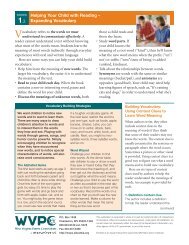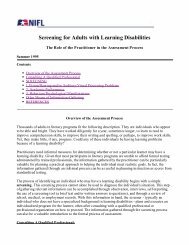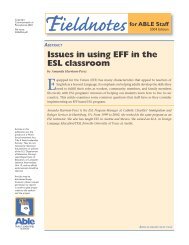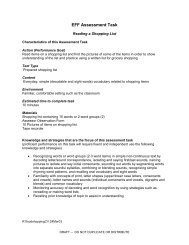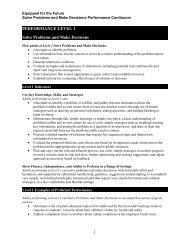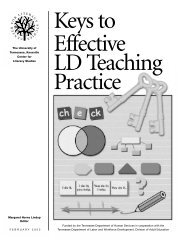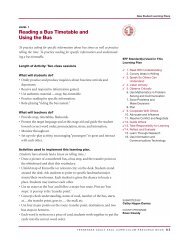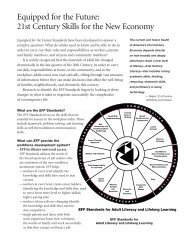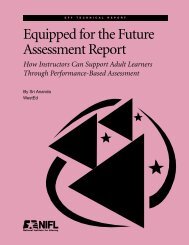Building Bridges Between School and Home - Center for Literacy ...
Building Bridges Between School and Home - Center for Literacy ...
Building Bridges Between School and Home - Center for Literacy ...
- No tags were found...
Create successful ePaper yourself
Turn your PDF publications into a flip-book with our unique Google optimized e-Paper software.
ate how much in<strong>for</strong>mation parents are given. Especiallyif you are trying to help parents developnew underst<strong>and</strong>ing or new skills, you may want toschedule several events <strong>and</strong> break up the contentinto manageable chunks.• Communication is key. Parents want to knowwhat is happening with their children. They wantto know how their children are progressing. Oftenthey want to underst<strong>and</strong> the expectations <strong>for</strong> children,<strong>and</strong> how their children compare with othersat each grade level.• It’s important to be honest with parents abouthow their children are doing. At the same time,recognize that the child is more than just his or heracademic per<strong>for</strong>mance. Every child is a whole personwith many gifts, <strong>and</strong> helping parents put thingsin perspective is important. A child may strugglein one area, but per<strong>for</strong>m beautifully in another.Whatever a teacher’s message is to parents, it mustbe truthful, sincere, <strong>and</strong> caring.• When you ask <strong>for</strong> parents to help children, bespecific. “Emma needs help with her reading” isn’tas useful to parents as “Please go with Emma to thelibrary each week this summer, check out a bookshe likes <strong>and</strong> take turns reading with her <strong>for</strong> 30minutes every day”.What did we learn about how schooladministrators <strong>and</strong> others can supporteducators who are trying to increaseparent involvement?Principals, district personnel, university faculty <strong>and</strong>others working with educators to increase familyinvolvement can really make a difference with theirsupport. We’ve learned that there are specific <strong>and</strong>powerful ways that administrators <strong>and</strong> others canhelp teachers move <strong>for</strong>ward with family involvement.• Let teachers know you value family involvement.Talk about family involvement <strong>and</strong> encourageteachers to share success stories, as well as challenges.• Look <strong>for</strong> places where several interested educatorscould come together on a regular basis tolearn more about parent involvement. Invite auniversity to host a class <strong>for</strong> teachers on the topic,or find a teacher with experience to lead a studygroup.• Be flexible <strong>and</strong> recognize that teachers will takedifferent approaches to family involvement. Familyinvolvement includes a lot — <strong>and</strong> teachers cancome up with their own ideas. Support them intheir chosen projects. Help them learn <strong>and</strong> growin expertise.• Support teachers as they take risks to involveparents more deeply. Notice their ef<strong>for</strong>ts. Talkwith them about it, <strong>and</strong> let them know you supportthem.BUILDING BRIDGES BETWEEN SCHOOL AND HOME: STORIES OF SUCCESS FROM LAWRENCE COUNTY, TENNESSEE12




